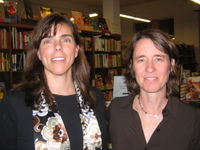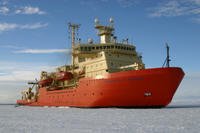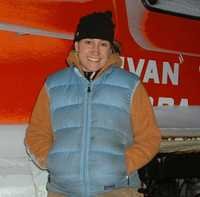Back in the Catskills
Late fall and winter are hiking season in the Catskills--especially if you are bushwacking. That's what I did with Connie (also known as Killer Connie, in red) and Edna on November 15 as we trudged up Mount Sherrill and North Dome. When we arrived at the trailhead in Westkill it was ten degrees out. I was not ready for the cold, even though I had on four layers. I kept all of them on during the hike and even added my down jacket on the descent! Our goal was that red canister in the background--there are canisters on the summits of all bushwack peaks in the Catskills--not a glorious view.
There are 35 peaks over 3,500 feet in the Catskills. Lots of people have their lists and the 3500 club promotes climbing all of them. Some hike them all in the winter as well. And then there are those who climb all of the peaks in every month of the year (this can take a year or two, depending on how obsessive you are). Connie is one such hiker--she has done this grid twice and is working on her third grid. She's an amazing woman: bakes great cookies we eat at the end of each hike, runs a health club, and practices reiki. Connie is keeping my Catskill list for me. I've got a few peaks to go...
In the Antarctic Ocean
 When I traveled to Antarctica, working on finding writers to contribute to Antarctica: Life on the Ice (then just a hope in my heart and an idea in my head), I spent a night in Christchurch, New Zealand. There, I shared a hotel room with a complete stranger, Julie Rose, a scientist who was heading out to research on the Nathaniel B. Palmer. I tracked down Julie recently to find out what she's doing and how her research is coming along. It wasn't hard to find her, since she works at Woods Hole Oceanographic Institute, the world's largest private, nonprofit, ocean research, engineering, and education organization. Read on to hear about Julie's experiences on a research vessel and to get a sense of polar ocean research.
When I traveled to Antarctica, working on finding writers to contribute to Antarctica: Life on the Ice (then just a hope in my heart and an idea in my head), I spent a night in Christchurch, New Zealand. There, I shared a hotel room with a complete stranger, Julie Rose, a scientist who was heading out to research on the Nathaniel B. Palmer. I tracked down Julie recently to find out what she's doing and how her research is coming along. It wasn't hard to find her, since she works at Woods Hole Oceanographic Institute, the world's largest private, nonprofit, ocean research, engineering, and education organization. Read on to hear about Julie's experiences on a research vessel and to get a sense of polar ocean research.
When I traveled to Antarctica, working on finding writers to contribute to Antarctica: Life on the Ice (then just a hope in my heart and an idea in my head), I spent a night in Christchurch, New Zealand. There, I shared a hotel room with a complete stranger, Julie Rose, a scientist who was heading out to research on the Nathaniel B. Palmer. I tracked down Julie recently to find out what she's doing and how her research is coming along. It wasn't hard to find her, since she works at Woods Hole Oceanographic Institute, the world's largest private, nonprofit, ocean research, engineering, and education organization. Read on to hear about Julie's experiences on a research vessel and to get a sense of polar ocean research.
"I met Susan in 2004 when we were roommates in Christchurch before departing for the Antarctic. Susan and I parted ways shortly after we met, when she left for the ice by air and I set sail from nearby Lyttelton onboard the RVIB (Research Vessel Ice Breaker) Nathaniel B. Palmer. The Palmer, or NBP according to Raytheon lingo, is one of the vessels commissioned by the National Science Foundation for ocean-based research in the Antarctic. The ship can break through several feet of sea ice and is able to navigate through the rough, stormy weather common to the Southern Ocean. The NBP can hold up to 37 scientists and 22 crew members, and has lab benches, cold rooms, wet labs, computer labs and even a stockroom of common lab (and craft) supplies. As far as research vessels go, the NBP, its crew and the Raytheon support staff are first-rate, which makes research cruises (relatively) easy and (relatively) less stressful.
Working on a ship is very rewarding but at times frustrating and difficult. As with any field research, an enormous amount of time goes into planning and preparation. When the weather is bad, not only can no samples be collected, but often no work can be done in labs because the ship’s motion makes it too dangerous (or the researchers are too seasick!) At the same time, research cruises are incredibly productive, intense and often exciting. A huge amount of work and data get collected in a short period of time, and a tight community forms, with 60 people working, eating and sleeping together on a roughly 300 foot long ship for over a month. I’ve found that a lot of great ideas and new, unexpected collaborations can form on research cruises as people with very different backgrounds and perspectives interact on a daily basis. And while research cruises are typified by intense periods of work, people still find time for fun and creative activities. Whether making birthday costumes for fellow passengers, conducting knitting and language classes, watching movies from the huge selection of DVDs available on the ship, or even the occasional rendezvous with international research vessels, the spirit of community on a research vessel makes the time fly by.
I have been on five cruises to the Ross Sea, Antarctica on the NBP with two separate projects. I am a microbiologist and ecologist, and am interested in the microorganisms living in the coastal ocean that surrounds the Antarctic continent. A lot of people think of biology in the ocean in terms of a food chain: the phytoplankton are microscopic plants harvesting the sun’s energy, they get eaten by krill, who get eaten by fish, who get eaten by whales or penguins or seals. However, there is actually a dynamic and fascinating food web of predators, prey and recyclers just within the microbes themselves. I’m very interested in how this microbial food web may be affected by changes that scientists have predicted for the future ocean, including such seemingly disparate (but actually closely linked) factors such as temperature, CO2, iron concentrations and light.
The Ross Sea is a wonderful place to do research in microbial ecology because it is the home of one of the largest annual blooms of phytoplankton in the world. It may seem surprising that plankton can thrive in what we perceive as a hostile, forbidding environment. But every year, when daylengths get longer and light levels increase, this nutrient-rich region becomes a hotbed of microbial activity. The phytoplankton blooms that regularly form are populated by either Phaeocystis antarctica (a small flagellated microbe that can form colonies big enough to see with the naked eye) or a mixed assemblage of diatoms (a diverse group of microbes enclosed in shells of silica, that can range in size over several orders of magnitude). Scientists aren’t sure why these two types of phytoplankton grow to such high abundance in the Ross Sea every year, or what causes one to dominate the other in different areas of the Ross Sea, but understanding these two questions will be very important to understand the biology and chemistry of Antarctica’s coastal oceans."
Thanks, Julie, for letting us in on your research!
Blogs and websites from some of the Antarctic cruises:
http://www.whoi.edu/sbl/liteSite.do?litesiteid=2530
http://www.vims.edu/bio/corsacs/cruise_2006.html
Thanksgiving on Ice
 Happy Thanksgiving! For those of you sitting warm inside, watching football and smelling the turkey roasting I want you to send a warm thought to our friends on the ice who are not eating turkey. To give a glimpse of what Thanksgiving can be like on the ice, I'm offering up the first few paragraphs of Traci McNamara's richly detailed essay from Antarctica: Life on the Ice. The woman in blue with the marvelous warm smile is Traci. Enjoy!
Happy Thanksgiving! For those of you sitting warm inside, watching football and smelling the turkey roasting I want you to send a warm thought to our friends on the ice who are not eating turkey. To give a glimpse of what Thanksgiving can be like on the ice, I'm offering up the first few paragraphs of Traci McNamara's richly detailed essay from Antarctica: Life on the Ice. The woman in blue with the marvelous warm smile is Traci. Enjoy!
We Ate No Turkey: A Holiday on Ice
Traci J. Macnamara
Instead of spending Thanksgiving Day as I usually did in Colorado Springs—watching the Macy’s parade on TV in my pajamas--I was shivering in my work clothes on the McMurdo Ice Shelf, learning how to make a storm-worthy shelter by cutting dense snow into blocks with a paper-thin saw. Snowcraft, as our mountain-savvy instructor called it, was only one portion of McMurdo Station, Antarctica’s two-day survival skills course optimistically called Happy Camper School.
Happy Thanksgiving! For those of you sitting warm inside, watching football and smelling the turkey roasting I want you to send a warm thought to our friends on the ice who are not eating turkey. To give a glimpse of what Thanksgiving can be like on the ice, I'm offering up the first few paragraphs of Traci McNamara's richly detailed essay from Antarctica: Life on the Ice. The woman in blue with the marvelous warm smile is Traci. Enjoy!
We Ate No Turkey: A Holiday on Ice
Instead of spending Thanksgiving Day as I usually did in Colorado Springs—watching the Macy’s parade on TV in my pajamas--I was shivering in my work clothes on the McMurdo Ice Shelf, learning how to make a storm-worthy shelter by cutting dense snow into blocks with a paper-thin saw. Snowcraft, as our mountain-savvy instructor called it, was only one portion of McMurdo Station, Antarctica’s two-day survival skills course optimistically called Happy Camper School.
The course, required of all workers and scientists at McMurdo, started
on a Thursday morning in the Field Safety Training Program conference
room, where our instructor Brian led twelve first-timers to Antarctica
through the lecture portion of the course. Novices, we were. But it
was Brian’s job to get us into Extreme Cold Combat Shape in less than
forty-eight hours, and by the end of our tenure on the ice shelf, we
would be firing up stoves and lashing down mountain tents, all—of
course—with great rapidity in order to outsmart the gale-force winds
and popsicle-death scenarios he concocted in order to keep us moving
quickly. When he wasn’t in Antarctica, Brian—tight-bodied and exuding
a spirit of adventure--worked as a guide in Alaska, but at McMurdo, he
was a member of the highly respected Field Safety Training Program team
(F-STOP for short), a group of sexy men and women who spent their lives
in rugged environments and then migrated south for the austral summer
to teach McMurdo’s scientists and support staff how to survive them.
After Brian introduced us to our Happy Camper objectives, he briefed us
on cold-weather health hazards, their symptoms, and their remedies.
Before lunch, I felt confident knowing the basics of hypothermia and
its telltale signs—the fumbles, mumbles, and grumbles.
“Talk to your partners to determine their LOC,” Brian said while
pointing to a white board scribbled with notes about how cold weather
affects a person’s level of consciousness, “and help them out before
they get into that irreversible phase. If you notice that anything’s
off, start with some food and water and get them moving around.”
Besides those suggestions, Brian offered a few other ideas about how to
prevent and treat hypothermia while he gestured with his hands and we
watched, motionless and mostly bored, from our chairs.
Of hypothermia’s remedies, one above the others captured my
imagination. F-STOP Brian told us that it is possible to warm up a
hypothermic body by stripping it naked and putting it in close
proximity to another naked body. “In extreme cases,” he clarified, “you
can use direct body heat to re-warm a hypothermic individual.”
Ideally, the second naked body would be warm, and these two naked
bodies together would be skin-to-skin within a sleeping bag so that an
ailing individual could reap the thermodynamic benefits. A few giggles
followed and a few glanced around the room.
To read the rest of the essay you have to buy the book! www.susanfoxrogers.com
Into the Cold: Antarctica travels to Minneapolis
 Don't we look like cousins? Katy Jensen on the left, me on the right. We read together from Antarctica: Life on the Ice on November 11 at Mager's and Quinn (a fabulous bookstore--both new and used) on a balmy early evening in Minneapolis. Katy--whose essay is about wintering at the South Pole--finds Minneapolis too cold...
Don't we look like cousins? Katy Jensen on the left, me on the right. We read together from Antarctica: Life on the Ice on November 11 at Mager's and Quinn (a fabulous bookstore--both new and used) on a balmy early evening in Minneapolis. Katy--whose essay is about wintering at the South Pole--finds Minneapolis too cold...
We had an extraordinary audience. My real cousins Polly and Deborah Talen were there with their three girls Grace, Lydia, and Eliza (in reverse order of age). Polly is the funniest woman alive and Deborah is a founder of Rainbow Families. Victoria Nohl, a former student from Bard, showed up still looking like Queenie (her name while at Bard). But most of the standing-room only crowd was Katy's family and step-family. They stretched back into the stacks of books and listened, enraptured, while Katy read her beautiful and emotionally complex essay. When I first met Katy it was through her essay, which has an amazing grace and intelligence to it. Meeting her was that rare moment of person living up to their writing...and then adding that special something that comes only with sitting down and having tea with someone.
Here is Katy's account of the reading, which I post with a blush.
Don't we look like cousins? Katy Jensen on the left, me on the right. We read together from Antarctica: Life on the Ice on November 11 at Mager's and Quinn (a fabulous bookstore--both new and used) on a balmy early evening in Minneapolis. Katy--whose essay is about wintering at the South Pole--finds Minneapolis too cold...
We had an extraordinary audience. My real cousins Polly and Deborah Talen were there with their three girls Grace, Lydia, and Eliza (in reverse order of age). Polly is the funniest woman alive and Deborah is a founder of Rainbow Families. Victoria Nohl, a former student from Bard, showed up still looking like Queenie (her name while at Bard). But most of the standing-room only crowd was Katy's family and step-family. They stretched back into the stacks of books and listened, enraptured, while Katy read her beautiful and emotionally complex essay. When I first met Katy it was through her essay, which has an amazing grace and intelligence to it. Meeting her was that rare moment of person living up to their writing...and then adding that special something that comes only with sitting down and having tea with someone.
Here is Katy's account of the reading, which I post with a blush.
Katy writes: "For
me, there were two best things about the event at Magers and Quinn. One was
the overwhelming range of emotions associated with being on “this side” of
a reading... from apprehension to acceptance to the rushes of adrenaline
that kept me awake all night. But my favorite best thing
about the event was finally meeting Susan in person. Nobody understood how
we could have collaborated on a book without even talking on the phone, but
when we stepped into Lucia’s for tea, I felt like it was something we did
every week. And when the ball of leaves in my tea glass expanded into a magical
flower, it was both wondrous and appropriate. Susan has that effect on people:
she disarms them with candor and then delights them with vivid adventures.
I can’t wait to see what’s next!"
And I can't wait to see what's next for Katy, who has just started working for Lockheed Martin. She shared one story of meeting an astronaut she admired. She was a bit tongue-tied until he shook her hand and said, "I never thought I'd meet someone who has been to the South Pole." Katy hasn't just been to the South Pole, she has spent more than four years in Antarctica, including three winters at the South Pole, where, for two seasons she was the station’s first female area manager.
Here is a cool fact about the Antarctic: geographical features can be named for living people (unlike in the rest of the world where you must be dead to be remembered in this way). Five contributors to Antarctica: Life on the Ice have features named after them: Uberuaga Island, Joyce Peak, Ainley Peak, Guthridge Nunataks and for Katy, Jensen Rampart, a set of cliffs in the Darwin Mountains. Some day she hopes to visit her cliffs. And I want to tag along.
You can read more about naming on the continent in an Antarctic Sun article from November 12, 2000.




